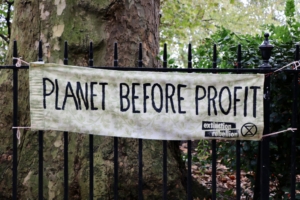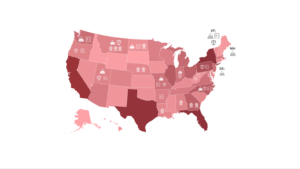2024 Is Coming
Here’s What You Need To Know
83 elections in 54 countries. That’s how many campaigns public affairs professionals will have to navigate in 2024. In the U.S., that will include at least 6,477 elections for everything from President, Congress, Governors, and other state-level positions, plus tens of thousands of county, municipal, and special district positions (fun fact: America has more than 500,000 elected officials). Even though they get far less notice, these down-ballot races – from statewide constitutional offices to local officials and even more obscure regulatory commissions – hold significant power over a wide range of industry sectors and policy areas.
Despite this major impact, the media will focus on polling in marquee races and political dynamics driving the parties’ efforts to turn out voters, which often have little to do with how newly elected officials will approach business policies or industry regulation. That leaves public affairs professionals scrambling to properly assess the candidates and anticipate the policy debates to come. Here’s what you need to know to avoid the scramble.
Down Ballot Doesn’t Mean Off the Radar
Down-ballot races are crucial to shaping everything from antitrust litigation to investment climates to environment regulations and beyond. Take state Attorneys General, like Ohio’s Dave Yost who is suing pharmacy benefits managers, or state Treasurers, such as West Virginia’s Riley Moore or Utah’s Marlo Oaks who are pressuring asset managers and banks over ESG commitments. As we noted last year, these officials’ policy activity has made campaigns for these offices far more robust.
Subscribe to Receive Insights
"*" indicates required fields
Similarly, local and county governmental bodies directly impact a diverse array of business operations. County and municipal officials are placing moratoriums on solar or wind projects, restricting AI use in hiring, hiking minimum wages for restaurant workers, banning single-use plastics, and much more. As a result, even previously obscure bodies like state public utility commissions are seeing an uptick in campaign action as more stakeholders seek to shape the work of these bodies.
For businesses and the public affairs professionals who guide them, a deep understanding of who is running for these offices as well as who and what shapes candidates’ views on your issue set is crucial. Even if you do not have immediate matters before them, their campaign rhetoric and actions once in office will impact the policy landscape when you do.
What Happens in Primaries Doesn’t Stay in Primaries
As we’ve highlighted previously, the marketplace of ideas does not strictly adhere to candidates’ win-loss records. Primary candidates’ influence in particularly can surpass their electoral outcomes. Their policy proposals, whether innovative or disruptive, can shift the political landscape and resonate with voters and politicians, irrespective of election results. As the twin tides of populism and progressivism shape each party’s policy agenda, the country’s direction in turn is being molded by these two extreme ends of the political spectrum. This ripple effect of primary contenders’ ideas, coupled with the potential for candidates who come up short at the polls to secure appointments to influential government roles, shows why it is important for public affairs professionals to closely monitor and understand the ideological currents shaping campaigns early in the election cycle.
Ballot Battle Royale Goes Beyond Candidates
Ballot initiatives and referenda are key yet often overlooked elements of elections. Both parties use them strategically to mobilize their voter base and influence the electorate on contentious issues. Earlier this month in Ohio, Democrats got a test run of a ballot measure to enshrine reproductive rights into the state constitution, and its success quickly prompted activists to set their sights on other states to help boost Democratic turnout in 2024. Republicans have leveraged this strategy as well.
Yet initiatives are not just about leveraging social and cultural issues to spike turnout. They can directly impact businesses on major issues like environmental and labor regulations. Activists and industry advocate alike use them to bypass or overturn polarized legislatures. While early in the cycle, already initiatives have been filed on critical issues like healthcare, taxation, and energy. Businesses need proactive engagement on which initiatives or referenda may reach next November’s ballot – and who is fueling interest in them.
The Media Is More Heat and Noise than Light or Insight
The mainstream media’s penchant for “horse race” journalism, which concentrates on poll standings and campaign strategies, poses a significant challenge for public affairs professionals. The emphasis on political rivalries and the dynamic of who’s leading or lagging comes at the expense of substantive policy discussions and simplifies complex political landscapes. Reporting that sidelines nuanced policy impacts and long-term consequences of election outcomes leaves public affairs professionals in a media environment rich in speculation and punditry yet lacking in the analysis they need to thoroughly assess candidates and their plans to govern.
Likewise, most of today’s media have aligned along ideological lines to cater to particular audiences, with biased reporters driving narratives that resonate with their selected news consumers while omitting or misrepresenting contrary information. Just as many deride politicians of leveraging redistricting to “choose their voters,” media companies leverage agenda-driven worldviews to cultivate their reader- or viewership, creating echo chambers where complex issues are reduced to binary debates. This environment makes it difficult for public affairs professionals to obtain facts and meaningful analysis.
Now Is the Time to Find Your Friends and Understand Your Opponents
Right now, many public affairs professionals are in the midst of annual budgeting processes to ensure they have the necessary resources to protect and advance their organization’s interests as the 2024 campaign unfolds. At Delve, our well-honed playbook helps you identify and secure the resources you need for public affairs success, starting with a risk assessment on which issues and jurisdictions are likely to pose the greatest challenges (or opportunities) and stakeholder mapping that surfaces potential allies and likely opponents among candidates as well as other groups and individuals shaping the campaign debate and the policymaking that follows.
Putting your public affairs operation at an information advantage in 2024 requires a focus that extends beyond top-tier races, recognizing the significant influence of down-ballot positions on policy and regulation and digging deep to remain attuned to the evolving political landscape. To cut through the noise of “horse race” journalism and partisan narratives, public affairs experts need reliable, in-depth analysis from a trusted partner. As you prepare for the coming election cycle, Delve is here to give you a decisive edge and empower you to not just anticipate the future but shape it.



